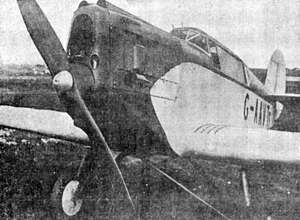Hendy 302
| Hendy 302 | |
|---|---|

| |
| Role | Two-seat cabin monoplane |
| Manufacturer | Hendy Aircraft Company |
| Designer | Basil Henderson |
| First flight | 1929 |
| Introduction | 1929 |
| Retired | 1938 |
| Produced | 1929 |
| Number built | 1 |
The Hendy 302 was a British two-seat cabin monoplane designed by Basil B. Henderson and built by George Parnall & Company Limited at Yate in 1929. Only one aircraft was built registered G-AAVT.
The 302 was a low-wing cantilever monoplane with fixed tailskid landing gear, powered by a 105 hp (78 kW) Cirrus Hermes I engine. It was flown by Edgar Percival in the 1930 King's Cup Race. It was rebuilt in 1934 as the 302A with an inverted 130 hp Cirrus Hermes IV and a revised cabin. It averaged 133.5 mph in the 1934 Kings Cup Race. It was used as a testbed for the Cirrus Major II engine before being withdrawn from use in 1938.
Specifications (302A)[edit]

Data from A.J. Jackson, British Civil Aircraft since 1919 Volume 3, 1974, Putnam, London, ISBN 0-370-10014-X, Page 253
General characteristics
- Crew: two
- Length: 22 ft 10 in (6.96 m)
- Wingspan: 35 ft 0 in (10.67 m)
- Gross weight: 1,900 lb (862 kg)
- Powerplant: 1 × Cirrus Hermes IV , 130 hp (97 kW)
Performance
- Maximum speed: 130 mph (210 km/h, 110 kn)
References[edit]
- A.J. Jackson, British Civil Aircraft since 1919 Volume 3, 1974, Putnam, London, ISBN 0-370-10014-X, Page 252
- The Illustrated Encyclopedia of Aircraft (Part Work 1982–1985), 1985, Orbis Publishing, Page 2155
- "Hendy", Flight, vol. XXII, no. 1143, p. 1296, 21 November 1930 – via archive.org
